Speech Some Current Issues in Banking

Bernie Fraser
Governor
Talk to the New South Wales State Committee, Australian Institute of Bankers
Sydney –
PDF version 75KB
As supervisor of the banks, the Reserve Bank has been likened to the shepherd tending his flock. Keeping the flock intact over the past decade, after the regulatory fences came down, has had its moments. A couple have wandered off, and a couple have lost more than their tails. But no carcasses litter the landscape. Indeed, the flock today is looking stronger and healthier than it has for some time, although still requiring careful husbandry.
Today I plan to focus on a few topical subjects, namely lending for housing and for small businesses, and the vexed issue of bank interest margins. I do so from a perspective which embraces both prudential supervision and macroeconomic policy. If there is a single theme, it is that while we have quite a lot of competition in our banking system, we could benefit from more – even if, at times, there is the appearance of having too much of a good thing!
Bank Lending
Banks are the major source of debt finance for both households and businesses, accounting for about three-quarters and two-thirds respectively of all debt finance provided to those sectors. Healthy banks, able and keen to lend, help make for a healthy economy. Happily, our system is in better shape now than it was a few years ago:
- non-performing loans of the banks (i.e. loans on which full interest payments are not expected or are overdue 90 days) now represent, on average, about 2½ per cent of assets, compared with a peak of 6 per cent in early 1992 (Graph 1a);
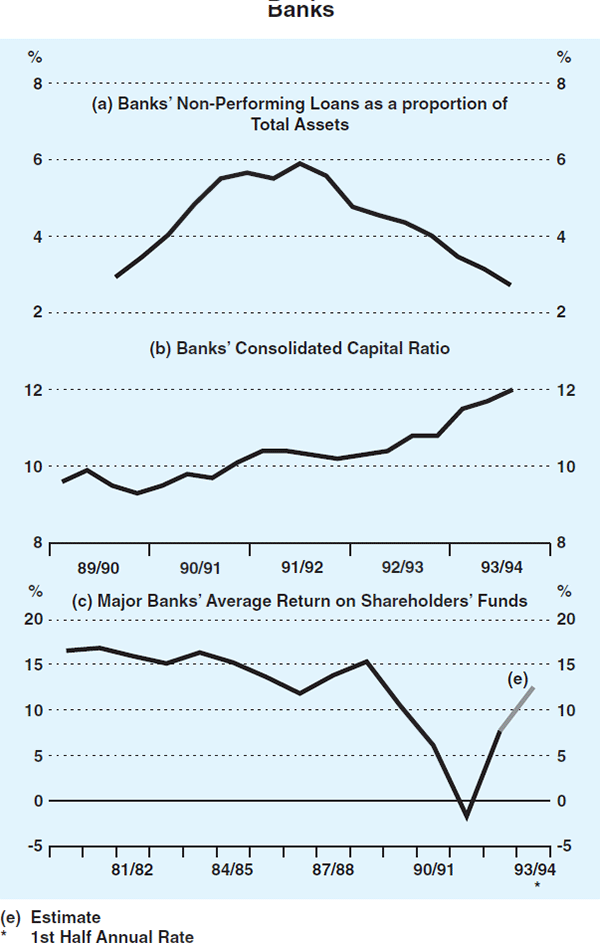
- the average capital ratio across the banking system is close to 12 per cent, well above the 8 per cent minimum requirement (Graph 1b); and
- profitability has recovered (Graph 1c), mainly because of reduced provisions for bad debts and lower operating costs.
Good and sustained profits are one sign of a healthy bank and, consequently, profitability is an important focus for supervisors (and depositors). It is by no means the only focus, however; as well as being profitable, the Reserve Bank looks to the banks, to the extent these things are reconcilable, to be efficient intermediaries, and to be responsive to the needs of the economy and the community.
Given their improving health, the banks are well placed to finance a growing economy. They are also, I believe, keen to do this. In March 1994, total credit extended by banks to the private sector was about 7 per cent higher than a year earlier, its highest growth rate for three years.
Lending for Housing
Looking behind this growth in total credit, we see that it has occurred almost entirely in lending for housing (Graph 2). Over the past two years, banks' housing loans outstanding have grown by 19 per cent per annum. Building societies and other non-bank institutions also have expanded their lending into this competitive market. Over the year to March 1994, total housing lending has grown by about 21 per cent, following an increase of 18 per cent in the preceding year.
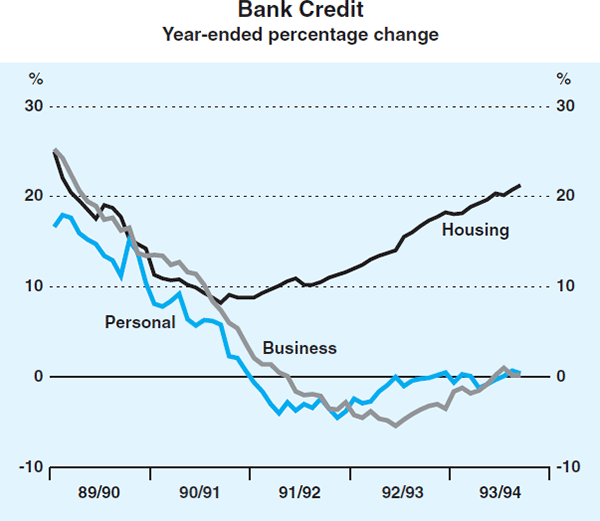
Some people have suggested that the banks' appetite for housing loans has been whetted by the concessional risk weight applied to housing in the capital adequacy arrangements. These arrangements, which have been in operation since 1988, require banks to hold capital equivalent to 4 per cent of their housing loans, but 8 per cent in respect of most of their other loans. In other words, loans secured by residential mortgages can be funded by 4 per cent capital and 96 per cent deposits, whereas ordinary loans require 8 per cent capital and 92 per cent deposits.
This advantage, however, is not all that large – it is estimated to be worth about half of one percentage point on the average housing loan interest rate (calculated as 4 per cent of the difference between the cost of capital and the cost of deposits). The lower weight, moreover, can be justified by the banks' extremely low default experience with housing loans.
The main factor driving the recent strong growth in housing lending is not this regulatory device but the best level of housing affordability in almost a decade – in part, reflecting the lowest nominal housing interest rate since 1974. The associated increase in housing activity has been a normal and helpful part of our cyclical recovery. To this time at least, there are few signs of the industry overheating, or of large, widespread rises in house prices.
But we can have too much of a good thing, and we are looking to housing lending to slow down. As we have said before, we would be concerned if lending for housing were to go on growing at 20 per cent. These concerns are macroeconomic rather than prudential, although the latter are not entirely irrelevant. The banks do need, for example, to keep to prudent loan to valuation ratios in their housing lending. Even then, problems could still arise in individual cases – particularly for borrowers – if circumstances were to change in unexpected ways. Those user-friendly computers which feature so prominently in bank advertisements would seem an ideal vehicle for borrowers to explore the full range of contingencies – to check what their repayments would be in the event of, say, higher interest rates.
The macroeconomic concern, of course, is that if this lending were to continue to grow at recent rates it would risk sharp rises in house prices and a return of asset price expectations of the kind last seen in the late 1980s. That situation has not been reached – indeed, housing lending and dwelling investment are both showing some signs of flattening out, albeit at high levels. Developments in these areas are being monitored closely.
Personal Lending Secured by Housing
Not all lending secured against houses is for the purchase or extension of those houses. Increasingly, banks are allowing – even enticing – consumers to borrow for other purposes as well, with the advantage of relatively lower home loan interest rates. What should we make of a situation where loans for almost any consumption purpose can be included in home loans?
Again, prudential and macroeconomic policy issues are involved. From the latter perspective, it would be perverse if these products were to result in more of the nation's savings being channelled into consumption when the emphasis should be on marshalling those savings for the expected – and necessary – lift in business investment. It is not clear that significant diversion is occurring at this time, but the situation is being watched.
From a prudential perspective, this lending – again within limits – need not be a cause of concern, given the good track record of loans secured against housing and the relatively light debt burdens of Australian households (see Graph 3). Rather, it can be seen as an illustration of how competition among the banks can benefit the man in the street, enabling low interest housing borrowing to be substituted for higher interest credit card or personal loan borrowing.
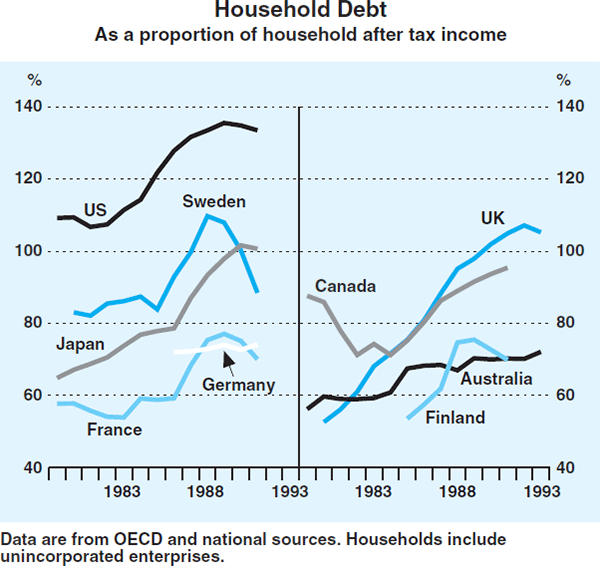
What is ‘within limits’ is a matter of judgment. Current debt ratios appear comfortable enough, with debt service payments equivalent to around 8 per cent of household income, compared with levels of 6 per cent in the 1970s and 10 per cent in the 1980s. Some increase, therefore, will hardly be fatal but, again, we need to avoid making too much of a good thing. Households might feel comfortable with current ratios but in some cases this will be because current interest rates are relatively low (Graph 4). Interest rates, however, cannot be assumed to remain at these levels. At some point in the business cycle, they are likely to go higher. Moreover, wage rises, which in the past have tended to ease the burden of housing repayments over time, will be much smaller in a low inflation world.
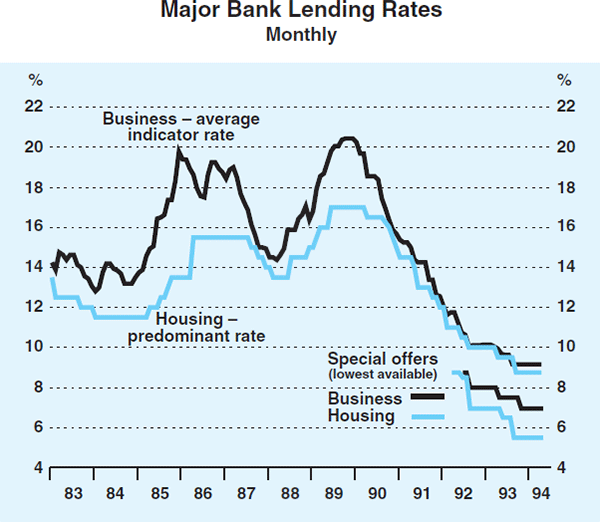
It would be imprudent, for borrowers and lenders alike, not to allow for such developments. Borrowers must take individual responsibility for their decisions, and they should be mindful of the consequences of changed circumstances on increased levels of indebtedness; the fall in house prices and the rise in unemployment in the recent recession in the UK illustrate the problems that can befall over-indebted households. As to the banks, we certainly expect them to be alert to the risks of changing circumstances, and to take them into account when lending to customers, as envisaged in the Code of Banking Practice. And they need to be careful not to push their new products to the point where historically low default rates on housing loans start to creep up.
Some of you might be wondering whether the Reserve Bank should do more. How far the Bank should go in stripping banks and households of the responsibility for their actions is a tricky question. We know from experience that banks and their customers will make some mistakes, which the Bank could not stop even if it tried. Given our deregulated framework, we believe the best course is for the Bank, in its on-going oversight of the banks, to do what it can to heighten awareness of the risks banks and their customers might be running. If, notwithstanding this, some go too close to the edge and fall over, this will be unfortunate – and the shepherd will, no doubt, be blamed!
Business Investment
As noted earlier, total business credit has declined somewhat from the peak levels of three years ago. This experience appears to be common to both large and small businesses. Over this period, firms have relied heavily on internally generated cash flows and new equity raisings to meet their funding needs. Those funds have been used mostly to repay debt, rather than to finance new investment. It is this lack of interest in undertaking new investment, rather than a lack of interest on the part of banks, which probably explains much of the fall in business lending (although the preoccupations and cautions bred of the late 1980s excesses and subsequent recession were no doubt important contributory factors).
The scene is set for business investment to bounce back. Profits are good, and while business surveys are not yet indicating any general pressure on physical capacity, rising domestic – and, prospectively, international – activity will change this. We have also moved into a new, low inflation environment – something which, I trust, firms have noticed and are factoring into their calculations of the nominal return they require from their investments.
The sooner business investment moves up, the more confident we can be that premature capacity shortages will not frustrate sustained jobs growth with low inflation. Business demand for bank credit can be expected to rise as investment rises.
Lending to Small Business
Bank finance is especially important for small and medium firms which cannot go to capital markets for funds. The Reserve Bank has made no secret of its wish for banks to become more involved in lending to such businesses. Not only are they major generators of exports and jobs, but also they are natural customers of the banks. Again, we point these things out to the banks and we urge them to switch some of their energies from housing to small businesses but we stop short, in our deregulated environment, of directing them to lend in particular volumes.
A popular perception is that small businesses are being constrained by availability of bank finance. Anecdotes abound but hard data are scarce. We are, however, now getting a better feel for small business lending, following the establishment of an advisory panel, the introduction of a new statistical collection, and the commissioning of two surveys of small businesses.
Some of our findings were published in the Bank's Bulletin for April. (That article is to be reproduced, I understand, in the AIB's journal in June.) In brief, our findings suggest that access to bank credit is not a major obstacle to the expansion of most small and medium businesses. This is in line with indications from other surveys. Although small businesses have a number of criticisms of banks, and the general view is often expressed that banks are unwilling to lend, relatively few small businesses are actually refused finance. Some are refused, of course, but this has always been the case, and always will be. Small businesses pay more on average for a bank loan than larger businesses, but the difference does not seem to be disproportionate to the greater risks and administrative costs associated with such lending.
I am happy to observe that many banks are now making greater efforts to market loans to the small and medium sized business sector. Over the past year or so, more banks have been positioning themselves in this market and offering special deals. I would like to think that this is at least partly in response to Reserve Bank encouragement, and to the decision to pay a market rate of interest on the Non-Callable Deposits (NCDs) held by the banks with the Reserve Bank.
Whatever the reasons, many banks now offer discounted rates on special deals for new investment by small businesses. Generally speaking, a discount of 1½ – 2 percentage points is offered on the variable rates normally charged to business customers. One smaller bank is offering a business loan, secured by residential real estate, at the same rate of interest that home borrowers pay, with no added customer risk margins. Although not all that significant in the overall scheme of things, it illustrates the interest which smaller banks are now taking in lending to this sector and the competition they can provide here (as they have in housing).
The working relationships between banks and their customers also appear to be improving gradually, from the dismal depths reached during the recession. Some tension, however, is inherent in the relationship. Security is a case in point. Some borrowers complain that banks always want too much security. At the same time, there are some borrowers who would prefer to keep their equity out of the business and leave the bank to carry most of the risk. In a survey commissioned recently by the Reserve Bank, over 70 per cent of metropolitan small businesses believed banks insisted on too much security but relatively few reported they had been refused a loan in the past year because of insufficient security (or any other reason for that matter).
In this and other areas where problems have more to do with perceptions than realities, banks could do their own cause no end of good by being clearer and more sensitive in their dealings and communications with their small business (and other) customers. I believe there is a desire on the part of banks to lift their game and, in time, the training and information programs now underway should deliver better results.
Bank Margins and Related Issues
I turn now to the issue of bank interest rate margins – the difference between the interest rates at which banks borrow and the rates at which they lend.
This issue has been around for some time. It first rose to prominence in mid 1990, shortly after official interest rates had begun to fall. Claims were made at the time that banks were not passing on to borrowers the benefits of lower official rates but were instead increasing their margins and profits to help cover their mistakes in the late 1980s. Like a good shepherd, we investigated these claims. Our findings have been reported on a number of occasions, including in a special article in the May 1992 edition of the Bank's Bulletin, and in its recent Annual Reports.
The first task was to clear up some of the confusion about the concept. Many commentators viewed the margin simply as the gap between an individual loan rate, such as a business indicator rate, and an individual deposit rate, such as the overnight cash rate. Such measures can sometimes shed light on the size of the margin seemingly attached to individual products, but they do not do justice to the complexity of overall trends and broader issues in margins. Single measures cannot, for example, capture the substantial changes which have occurred over time in the composition of banks' loans and deposits. To give one illustration, since 1981 banks' low cost deposits have declined from over 50 per cent of total deposits to 15 per cent (Graph 5); this means that, at any given structure of interest rates, the banks have to pay a higher average cost for their funds now than they did in earlier periods.
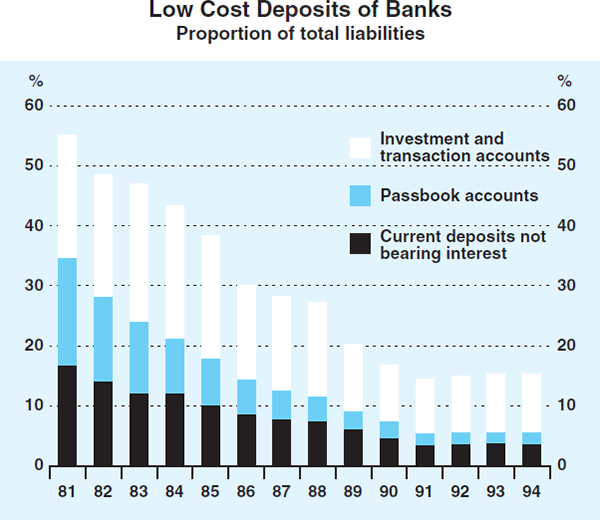
Rather than look at single measures, we believe it is more valid – when assessing the impact of interest rate movements on bank profits – to look at measures of average margins across all loans and deposits. This has been the focus of the Bank's work on margins. If we look at the difference between the average interest rate the four majors have earned on all their loans (including non-accrual loans) and the average interest rate they have paid on all their deposits, we see that there has been no significant change in the margin over the past four years; it has been quite steady at around 4 percentage points.
This is the ‘net’ interest margin (or ‘spread’) shown in Graph 6. If we want to see the effect of the growth in non-accrual loans, we can add in the estimated interest forgone by the banks on such loans. This gives the ‘gross’ interest margin (or ‘spread’), also shown in Graph 6; its level is a little higher but it shows much the same trend as the net interest margin.
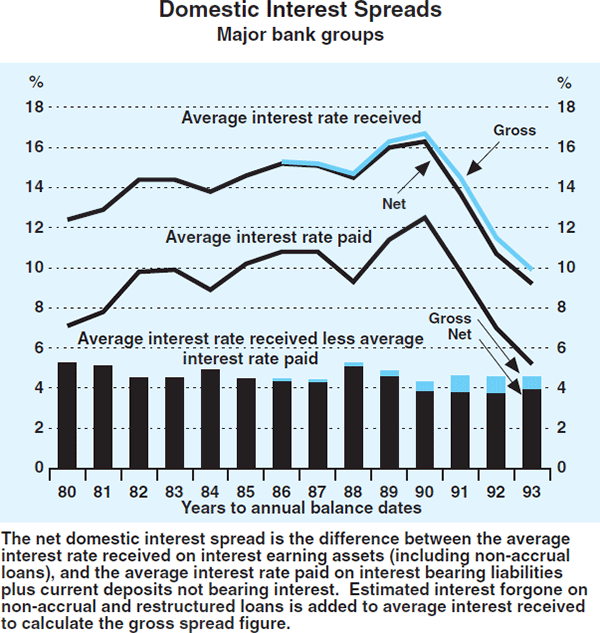
Looked at another way, the banks have not reduced the average cost of their deposits by as much as the reduction in official interest rates, because of competition for funds and the greater interest awareness of depositors these days. The average lending rates of the banks, however, have fallen in line with the fall in their average cost of funds. To the extent that the full reduction in official rates has not been passed on to borrowers, it has gone to depositors, not to the banks in higher margins.
To say that banks have not increased their profits by increasing their margins is neither to endorse current margins, nor to suggest that they are immutable. Indeed, we have said several times that we expect margins to decline over time, as competition within the banking sector heats up further.
More recently, the debate has shifted away from trends in margins over time to levels of margins: specifically, are the margins of Australian banks too high? They might be, but that is not something that is easily established, and certainly not from the data currently available on international comparisons of margins.
The two most quoted sources of international comparisons in the Australian debate have been the OECD and Salomon Brothers, the US investment bank. For what they are worth, both sources suggest margins in Australia are roughly on a par with those in the US and UK but higher than those in Japan, Germany and Switzerland. The data, however, are not worth very much: the basic problem with both sources is that they do not compare like with like.
The Salomon Brothers data relate to a small number of banks in several countries, but the banks are hardly comparable. The US ‘money centre’ banks (such as Citibank and Bankers Trust) and the large Japanese ‘city banks’, bear little resemblance to the four ‘majors’ shown for Australia. The OECD covers more banks and includes data for different sub-groups of bank, but the standardisation problem remains; the OECD acknowledges this and urges caution in using its data for comparative purposes.
Meaningful comparisons require that Australian banks be compared with broadly similar banks in other countries. This is not done at present. It makes no sense to compare the margins of the Australian majors, which are predominantly retail banks operating large branch networks and offering a wide range of household and business products, with very large banks in other countries, which are predominantly wholesale banks servicing mainly professional money and securities markets. The latter banks will, inherently, deliver slimmer margins than the Australian banks.
Personally, I doubt whether, even with considerable research, we will ever produce entirely satisfactory international data on bank margins. Given the interest in the topic, however, and the shortcomings in the existing data, we indicated to the House of Representatives Banking Committee some time ago that we would try to compile some comparable data. To this end, we are currently assembling data on a selection of banks in the US, Canada, UK, New Zealand and one or two continental European countries which are closest to the Australian majors in terms of size, product mix, branch structure, regulatory environment, and so on. We will be looking not only at margins – which relate to only part of a bank's activities – but also at broader measures of profitability and efficiency. We hope to be in a position to include some results in the Bank's Annual Report in August.
We will have to await the completion of that work to assess the usefulness of the results. But we do not need international data to ask questions about whether the performance of Australian banks can be improved and existing margins lowered. As indicated earlier, we expect margins in Australia to narrow over time as banks compete more vigorously for business, and for the deposits to fund them. In our view, effective competition among banks is the best way to ensure ‘acceptable’ levels of bank margins, profits and efficiency – ‘acceptability’ being defined not in terms of rankings with other countries, but in terms of the amount of competition and other changes which we, as a community, are prepared to accept to see lower margins in our banks.
I will conclude with some additional comments which might help to make clearer what I have in mind here.
- If the margin on a particular bank product is perceived to be on the ‘fat’ side, competitive pressures should trim that back over time. So long as there is effective competition, other players will enter the market for the fat margin products and compete down the margin. Housing lending is an area where many observers believe margins err on the generous side, and competition does seem to have stepped up in this area – not only in the special deals being offered by different banks but also through the entry of non-banks (such as GIO and, more recently, the ACTU/National Mutual venture) into this market.
- Maintaining a competitive environment is, therefore, essential to keeping downward pressure on margins. Our banks are already quite competitive and, with the problems of the early 1990s now largely behind them, should become even more so in the future. We have a large number of banks and there are no special barriers to entry, although the restrictions sometimes imposed on sales of existing institutions do not always give top billing to considerations of competitiveness. The arrival of foreign banks in the mid-1980s served to increase competition in Australian banking, and the further liberalisation of policy in 1992 will, at the margin, work in the same direction; so far, six new banking authorities have been issued.
- Competition in the real world, however, seldom works in the manner described in the textbooks. There it is assumed that customers will actively play their part, and be prepared to shop around and switch their business if necessary. If they do shop around, they are likely to discover that they can get better deals on particular products from different banks. But in practice many borrowers are reluctant to shop around for a number of reasons, including inertia and the convenience of current ‘packaged’ services (comprising housing loan, cheque account, credit cards and so on), reluctance to try non-traditional sources of funds, and the actual or perceived costs of switching some or all transactions from one bank to another. To the extent that customers do not shop around for individual products, however, the competitive pressure on banks is reduced.
- Associated with this last point is the extensive cross-subsidisation of different groups of services and customers which still exists in Australian banking. Many customers, for example, pay few charges for most of their transactions, provided they maintain a relatively small minimum transaction account balance. Competition should, over time, lead some banks to undercut others on the products that are very profitable (the source of the cross-subsidies), while not offering the products that are unprofitable; for the reasons mentioned, however, this tends to be a slow process. But as it proceeds, banks will have to move to full cost pricing by making greater use of fees for services; if they do not move in this direction, they risk losing market share in profitable products, and increasing it in unprofitable ones. While some bank products will become cheaper, the rise in charges for others could be substantial; these will not be accepted quietly by most bank customers, but they do seem to be an inevitable consequence of more vigorous competition among the banks. At present, to the extent that costs of some services are not recouped directly from the users of those services, they are being recouped indirectly in other ways – some borrowers pay more while some depositors receive less than would otherwise be the case. In other words, margins are higher than they would otherwise be.
- The efficiency of the banking system in delivering its services is also important. The more efficient the banks are, the easier it will be for them to maintain good profits and lower margins. Banks have taken many steps in recent years to cut costs and in other ways become more efficient, and the effects are now beginning to show up in their bottom lines. Banks can, no doubt, be made more efficient still but many of the avenues for achieving this (such as further branch closures and staff reductions) will not be popular.
These, then, are some of the questions and constraints that need to be considered when we talk about bank margins. We are looking at them, along with the banks and a lot of others. The whole subject is clearly more complicated than might be inferred from international comparisons, even if those were not seriously flawed. It is, moreover, one where community expectations appear to be pulling in a number of directions at the one time. Everyone would like to see lower costs and margins, but not everyone is as keen to see the service fees, branch closures, staff reductions and other changes necessary to bring them about. Those changes must, however, be part of the process.